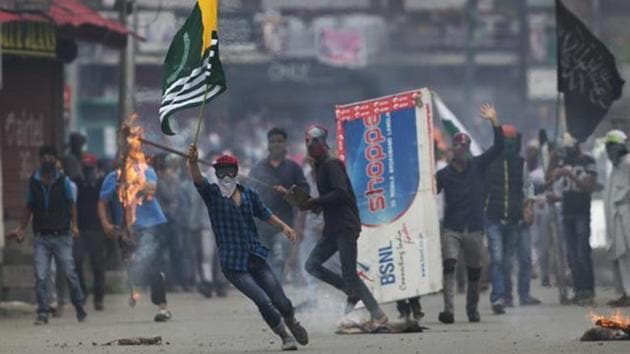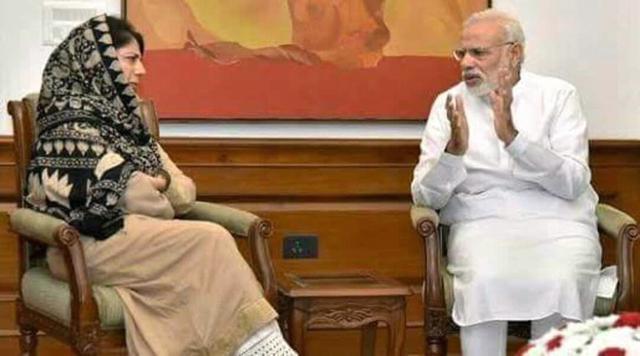How Jammu and Kashmir’s demand for autonomy has shaped up since Independence
Separatists want that people of Jammu and Kashmir should be given a right to chose whether they want to live in India, Pakistan or remain sovereign.
The issue of autonomy to the restive Jammu and Kashmir, provided under Article 35(A) of the Constitution, has been under attack from the ruling Bharatiya Janata Party amid opposition from state parties and Congress.

It gives special rights to the state’s permanent residents and disallows people from the rest of India from buying or owning immovable property in Jammu and Kashmir, settle permanently, or avail themselves of state-sponsored scholarship schemes. It also forbids the state government from hiring such people.
The Supreme Court will hear a petition on Monday seeking the repeal of the Article 35A by Delhi-based NGO, We the Citizens. It says the state’s autonomous status granted by Article 35(A) and Article 370 of the Constitution discriminates against fellow citizens from the rest of the country.
Here is how the demand for autonomy has shaped through the years:
What is the autonomy issue?
Jammu and Kashmir, a Muslim majority princely state led by a Hindu ruler Hari Singh, was toying with the idea of remaining independent with amicable relations with both India and Pakistan after India gained independence from the British in 1947.
However, after a Kabaili or tribal invasion by Pakistan, Singh asked the government of India for military help. The instrument of accession, which was a conditional accession with India, was signed by Singh on October 26, 1947, and the Indian Army landed in Kashmir a day later.
According to the instrument of accession, the state relegated powers related to defence, foreign affairs, currency and telecommunication to India and the rest remained with the state. The state had a president or sadr-e-riyasat and instead of a chief minister, there was a prime minister. Any amendment to the above clauses was only possible through an amendment to the Indian Constitution.
Read | SC to hear plea on Article 35A: All about law that grants special rights to J-K
The Indian government approached the United Nations where India and Pakistan agreed to a ceasefire. Subsequently, a resolution was passed in the Security Council asking both countries to grant the right of self-determination to the people of Jammu and Kashmir after both the armies withdraw from their respective position.
How did the content and contours of autonomy change?
National Conference patron Sheikh Abdullah, who became the first prime minister of Kashmir in 1948, was jailed in 1953 and his absence from state politics for 22 years led to the erosion of many aspects of autonomy.
After 1953, a president’s order stated that any matter pertaining to national interest or enemy aggression can be implemented through a presidential ordinance without a constitutional amendment. This doesn’t require ratification by the state assembly.
From then on, presidential orders reduced the state’s autonomy like extending the jurisdiction of the Supreme Court of India and Election Commission of India. The central laws were implemented and state’s powers were subsequently reduced to what was called the “state list’’. The state heads were changed.

In 1965, the Jammu and Kashmir assembly was forced to change the nomenclature of both the nominal and elected head. After this, a governor was elected not just by the state but was also the prerogative of the central government.
When was the last time Jammu and Kashmir seriously debated autonomy?
In 2000, the National Conference government led by Farooq Abdullah passed an autonomy resolution in the state assembly renewing efforts to get Kashmir the pre-1953 status. The resolution was, however, not accepted by the then NDA government led by prime minister Atal Bihari Vajpayee.
Where do parties stand on autonomy?
In 1975, Abdullah entered into an accord with the then prime minister Indira Gandhi. Abdullah, experts believe, his “fight with the Union of India was not on accession but greater autonomy’’ and the accord was a result of a promise that the pre-1953 position will be stated.
Both Peoples Democratic Party (PDP) and National Conference want the restoration of the pre-1953 position, which limited India’s control largely to foreign affairs, defence and communication. It is a stated position of both the parties. While National Conference calls it autonomy, PDP calls it self-rule.
Separatists, including both factions of the Hurriyat, demand right to self-determination as promised by the government of India at the time of the accession. They want that people should be given a right to chose whether they want to live in India, Pakistan or remain sovereign.
Why is BJP opposed to reopening the question of autonomy?
The demand for greater autonomy by Jammu and Kashmir has been branded as anti-national by the current ruling dispensation in the Centre. The Bharatiya Janata Party (BJP) although in a coalition with the PDP (which has self-rule as its stated position) believes in the complete merger of the restive state with India. Abolition of constitutional provisions - Article 35 A and Article 370 that give special status to Jammu and Kashmir have - been the stated policy of the right-wing party. Many petitions have been filed in the Supreme Court by people associated with the party.
How do NC and PDP differ on the question of autonomy?
The self-rule framework of the PDP is the party’s proposal for resolving the Kashmir issue. Political restructuring, economic integration between the two parts of Kashmir, demilitarisation and constitutional restructuring within the Indian Constitution are the highlights.
The self-rule document is firm on making Article 356 (imposition of President’s Rule) non-applicable to Jammu and Kashmir, for which a separate constitution and its special status under Article 370 formed the basis. The governor, it says, should be elected and rotated between Jammu and Srinagar.
National Conference believes in the restoration of autonomy and Article 370 to its original pristine form.
Get Current Updates on India News, Lok Sabha election 2024 live, Election 2024 along with Latest News and Top Headlines from India and around the world.




